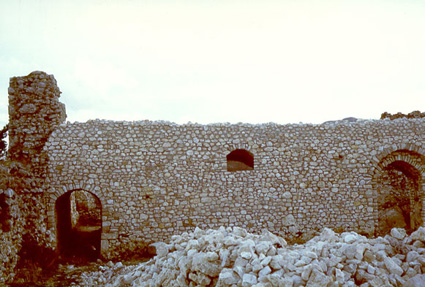![]() Castles
Castles
![]() Castle of Bojano
Castle of Bojano
 |
Castle
of |
The
ruins of this fortification are located at the top of the Civita, isolated from
the medieval town. The study of the planimetrical and structural characteristics
does not allow us to differentiate clearly between the Longobard and Norman
influences. Interpretation has been made even more difficult by recent works
that have homogenised parts of the masonry. The Pandone castle appears as the
outstanding element on a large plain on the lower slopes of the Matese massif,
controlling the traffic along the Pescasseroli-Candela sheep-track. Sections of
cyclopean walls have been discovered in the neighbourhood, indicating an early
Samnite fortification reused at later periods.
During the reign of Fredrick II the area was the scene of conflicts between the
representatives of the Emperor and Judith, wife of Count Tommaso di Celano. The Civita
is mentioned in the Registrum Friderici II: in a document dated 19
October 1239 the Emperor ordered the houses built near the fortress to be
demolished and the military structures to be promptly reconditioned. The castle
included an area where the population could occasionally find shelter, the
Countís residence in the centre, and an upper court. Of the structures of the
fortification, two large enceintes separated crossways by a ditch that exploits
the natural shape of the site are still visible. The site is fronted by the
ruins of a large rectangular hall, with only a section of the vaulted (depressed
arch) roof remaining. The openings show a marked inner splay. The courtyard
serves as drill ground and defence enclosure (diateichisma). Of the
original towers, the only surviving one is on the western corner, where the
remains of a cistern are also visible. Long sections of the medieval enclosing
wall with towers and gateways still remain, though they have been partly
incorporated in more recent buildings. Recent excavations have unearthed
important glazed ceramics from the 13th century.